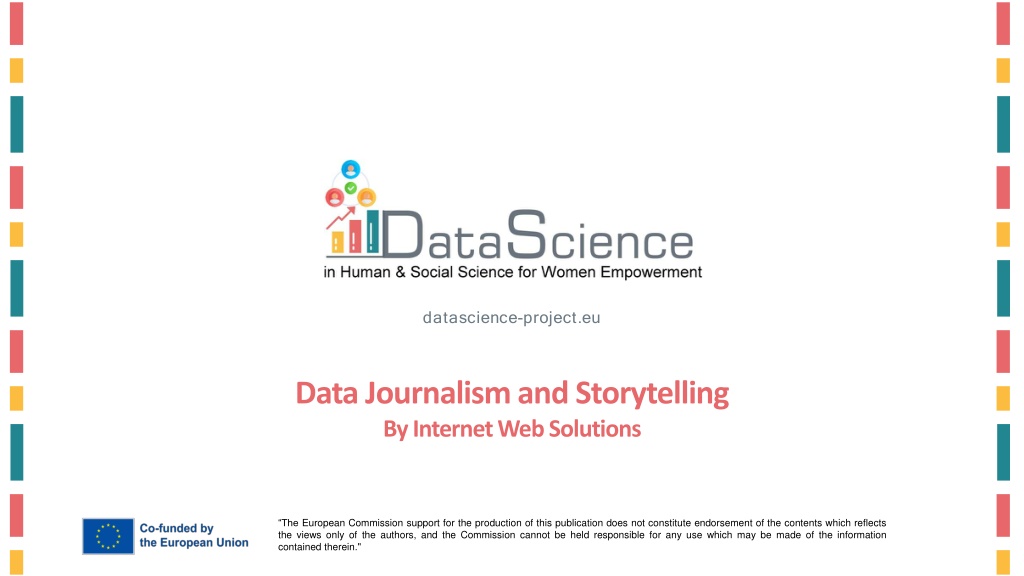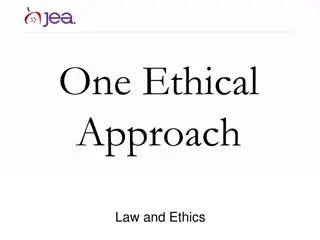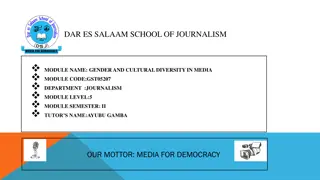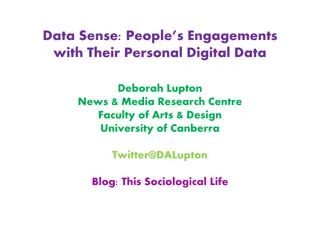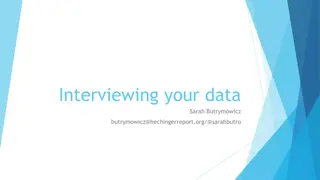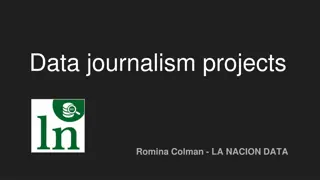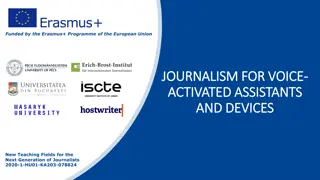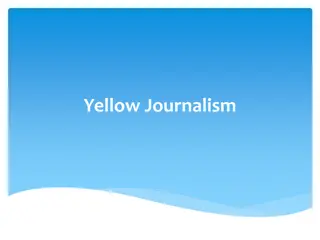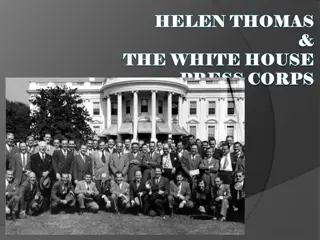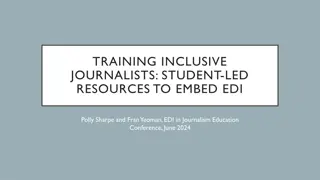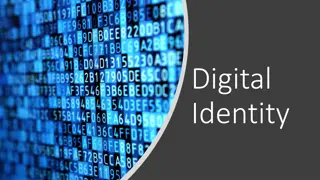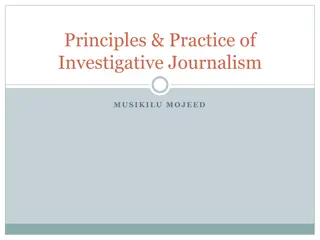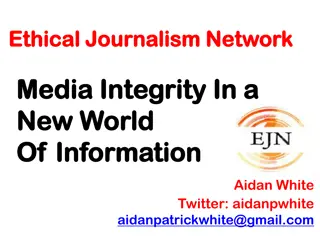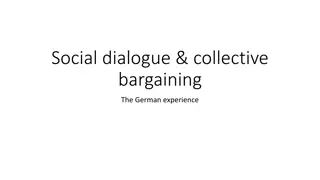Exploring the Evolution of Data Journalism in the Digital Age
Data journalism has transformed from a set of numbers on a spreadsheet to a powerful tool for storytelling in the digital era. This innovative approach utilizes data to make complex stories accessible and engaging for readers, revolutionizing the way news is produced and consumed. Embracing data journalism allows journalists to uncover insights, communicate trends, and connect with audiences in meaningful ways.
Download Presentation

Please find below an Image/Link to download the presentation.
The content on the website is provided AS IS for your information and personal use only. It may not be sold, licensed, or shared on other websites without obtaining consent from the author. Download presentation by click this link. If you encounter any issues during the download, it is possible that the publisher has removed the file from their server.
E N D
Presentation Transcript
datascience-project.eu Data Journalism and Storytelling By Internet Web Solutions The European Commission support for the production of this publication does not constitute endorsement of the contents which reflects the views only of the authors, and the Commission cannot be held responsible for any use which may be made of the information contained therein."
Index 1 3 2 Data Journalism 1. The new role of data 2. Definition 3. The new ways of journalism 4. Journalists data skills 5. Good data-driven news elements 6. Case study: Goalkeepers Data Storytelling 1. Communicating data 2. From data analysis to data storytelling 3. Key elements Data story 1. Why is story more effective? 2. The power of a story 3. Key story elements The European Commission support for the production of this publication does not constitute endorsement of the contents which reflects the views only of the authors, and the Commission cannot be held responsible for any use which may be made of the information contained therein."
Data Journalism 1. The new role of data 20 years ago, data meant a set of numbers ordered on a spreadsheet. Today, in the digital age in which we live, numbers can be used to express and explain any phenomenon or event that surrounds us. Numerical data are playing an increasingly important role in the production and distribution of information. Data can be used to transform something abstract into something understandable and connectable to everyone. All sectors are adapting to this transformation, including journalism: more and more news organisations (New York Times, Sky News, The Guardian...) are relying on data analysis and visualisation to produce and publish informative and engaging stories. The European Commission support for the production of this publication does not constitute endorsement of the contents which reflects the views only of the authors, and the Commission cannot be held responsible for any use which may be made of the information contained therein."
Data Journalism 2. Definition Data journalism is a type of journalism in which the use of data is used to tell complex stories. It can be defined as a new skill set to access, interpret and visualise data and digital sources. Data can be the source of data journalism or the tool used to tell the story, or both. This should not be seen as replacing, but rather as complementing traditional journalism. Good data journalism helps readers understand and draw conclusions about their world. For example, it can bring scientific discoveries to the forefront of a narrative and make them accessible to readers. The European Commission support for the production of this publication does not constitute endorsement of the contents which reflects the views only of the authors, and the Commission cannot be held responsible for any use which may be made of the information contained therein."
Data Journalism 3. The new ways of journalism Today, news comes as it happens, from a variety of sources (eyewitnesses, blogs, etc.), so the main focus of journalists shifts from being the first to report to explaining what a certain development might actually mean. There are invisible connections that conceal news and information that is often ignored. Data is the language of this network: small fragments of information that, while not always significant in an individual case, can be extremely valuable when viewed from the appropriate perspective. The European Commission support for the production of this publication does not constitute endorsement of the contents which reflects the views only of the authors, and the Commission cannot be held responsible for any use which may be made of the information contained therein."
Data Journalism 4. Journalists data skills Journalists are therefore increasingly required to be data literate. Developing skills in searching, cleansing and visualising data allows them to have: An unlimited number of sources to search for news articles Clean data to interpret (raw data is cumbersome information, often difficult to examine) The ability to read graphical representations of information, from which to derive stories to tell Journalists who master these techniques have the freedom to write articles based on facts and observations and will be able to create a solid evidence-based point of view, which can have a significant impact on the function of journalism. The European Commission support for the production of this publication does not constitute endorsement of the contents which reflects the views only of the authors, and the Commission cannot be held responsible for any use which may be made of the information contained therein."
Data Journalism 5. Good data-driven news elements 1) Good data: It is necessary to search for high quality data, ensuring that the collection methods, research subjects and any analysis are valid and free from bias. 2) Story from the data: Identify the central narrative line and make sure it is solid and consistent. 3) Storyboard and structure: For the story to be coherent and engaging, it is important to organise the content and determine which to include and which to leave out. It can be helpful to sketch out a map of the structure of the data story, as well as the data, visualisations and written content. 4) Clear narrative line: Care must be taken not to present the data as a set of numbers without sufficiently contextualising it. The role of narrative is crucial in helping the audience make sense of the information and data. 5) Interactivity: "Any sense of animation that you can bring into a piece really helps: you can have the feeling of interacting with the content." (Ronan Hughes, Output Editor of Sky News) The European Commission support for the production of this publication does not constitute endorsement of the contents which reflects the views only of the authors, and the Commission cannot be held responsible for any use which may be made of the information contained therein."
Data Journalism 6. Case study: Goalkeepers Goalkeepers is an annual report on the progress of the 17 goals of the 2030 Agenda for Sustainable Development by Bill and Melinda Gates. See, for example, the 2019 report: "Examining equality: How geography and gender stack the deck for (or against) you". This report is an example of an excellently presented data story. The solid data and information is embedded within a story featuring a little girl living in southern Chad, a Saharan country. Seeing the child's face helps the reader to better understand what the data presented in the report represents. The narrative line is clear and coherent, the story structure is solid, and the reading is made smooth and light thanks to the visualisation techniques and interactivity of the report: moving down while reading the page, images and diagrams appear on their own, zooming in or out according to the paragraph we are reading. The European Commission support for the production of this publication does not constitute endorsement of the contents which reflects the views only of the authors, and the Commission cannot be held responsible for any use which may be made of the information contained therein."
Data Storytelling 1. Communicating data If an insight is not understood and is not convincing, no one will exploit it and no change will occur from the information revealed from the data. Any insight worth sharing is probably best shared as a data story. Discovering key insights is one skill that requires a set of hard skills related to data analysis. Communicating these insights in a clear and compelling way requires other kinds of soft skills. Both are equally fundamental to deriving value from data. The ability to effectively communicate insights from a dataset using narratives and visualisations is called Storytelling. It can be used to contextualise data and inspire audience action. Designed by vectorjuice / Freepik The European Commission support for the production of this publication does not constitute endorsement of the contents which reflects the views only of the authors, and the Commission cannot be held responsible for any use which may be made of the information contained therein."
Data Storytelling 2. From data analysis to data storytelling The purpose of any data collection is to extract value from it. Once analysed, however, it is essential to be able to disseminate this value in order for it to be meaningful. When narrative is combined with data, it helps explain to the general public what is happening in the data and why a particular insight is important. In this sense, data storytelling is the tool that enables data analysts to translate information from the 'language of numbers' into a story and narrative that is accessible to users unfamiliar with data science. Designed by vectorjuice / Freepik The European Commission support for the production of this publication does not constitute endorsement of the contents which reflects the views only of the authors, and the Commission cannot be held responsible for any use which may be made of the information contained therein."
Data Storytelling 3. Key elements Data storytelling is an approach that involves the combination of three key elements: Data: Analysis of data using descriptive, diagnostic, predictive and prescriptive analyses can enable understanding the full picture and extract knowledge and insights from the data. Narrative: Storyline is used to effectively communicate the insights gained from the data, the context surrounding them and the recommended actions; it is a key vehicle for conveying information because it enhances our ability to understand. Visualisation: Transforming data into graphs, charts, images or videos allows us to see the data more clearly; they provide snapshots at a glance of the data, but without the context needed to explain why something happened. When you combine the right images and narrative with the right data, you get a data story that can influence and drive change. The European Commission support for the production of this publication does not constitute endorsement of the contents which reflects the views only of the authors, and the Commission cannot be held responsible for any use which may be made of the information contained therein."
Data story 1. Why is story more effective? The brain's preference for stories over pure data stems from the fact that the brain receives a large amount of information every day and has to determine what is important to process and remember and what can be discarded. When listening to a story, several parts of the brain are involved, including: Wernicke's area, which controls language comprehension; Amygdala, which processes emotional response; Mirror neurons, which play a role in empathy with others. When more brain areas are involved, the hippocampus, which stores short-term memories, is more likely to convert the experience of hearing a story into a long-term memory. The European Commission support for the production of this publication does not constitute endorsement of the contents which reflects the views only of the authors, and the Commission cannot be held responsible for any use which may be made of the information contained therein."
Data story 2. The power of a story Information obtained through data analysis, although logical and clearly reported, does not have the power to influence decisions and push the public to act. Business decisions are thought to be based solely on logic and reason, but neuroscientists have confirmed that emotions play a decisive role in decision-making. Narrative seems to be more effective in changing beliefs than writings specifically designed to persuade through arguments and evidence. Building a story from data insights dignifies creating a bridge from data to the emotional and influential side of the brain. People are moved by emotions, so attitudes, fears, hopes and values are strongly influenced by stories. The European Commission support for the production of this publication does not constitute endorsement of the contents which reflects the views only of the authors, and the Commission cannot be held responsible for any use which may be made of the information contained therein."
Data story 2. The power of a story Memorability: Stanford Chip Heath (author of Made to Stick) found that when students are asked to recall speeches, 63% of them are able to remember stories, but only 5% are able to remember a single statistic. The story is a tool that enables the transmission of information, ideas and insights in an extremely effective way mainly for three reasons: Persuasiveness: In a study conducted to test two variants of a Save the Children organisation brochure, it was shown that sharing life stories of African children is much more persuasive than reporting statistics on their living conditions. Engagement: Green and Brock's study (2020) show that the more readers are absorbed by a story, the more the story has an effect on them and their beliefs: when listening to a story, we tend to lower our intellectual guard and be less critical and sceptical. The story has the power to move us emotionally and make us lose sight of rational considerations. The European Commission support for the production of this publication does not constitute endorsement of the contents which reflects the views only of the authors, and the Commission cannot be held responsible for any use which may be made of the information contained therein."
Data story 3. Key story elements Data storytelling uses the same narrative elements as any other type of story. The following is an example of a data story proposed by Harvard Business School. Characters - The protagonists of our story are customers aged between 14 and 23, environmentally conscious consumers and your company team. Setting - The context: there s been a decline in sales among customers aged 14-23; to expose the setting of our story it could be very useful to exploit data visualisation techniques. Conflict - A viral social media post that highlighted the company's negative impact on the environment. Again, data visualisation and even the incorporation of research on consumers' growing environmental awareness and concern could be particularly useful here. Resolution - Presentation of a long-term goal to resolve the situation. In this case, the change to more sustainable production practices and a marketing plan to give visibility to this change. We can exploit data visualisation techniques to show the required investment and profit expectations. The European Commission support for the production of this publication does not constitute endorsement of the contents which reflects the views only of the authors, and the Commission cannot be held responsible for any use which may be made of the information contained therein."
Summing up It is increasingly necessary to possess a set of skills that enable them to disseminate the information hidden in the data to the general public. All areas of work have started to adapt to the huge increase in data at our disposal. Thus, Data Journalism was born. The main tool of data journalists and storytellers is the data story. The data story is built on the basis of specific data in order to share the value extracted from their analysis. Data journalists use data both to research new news and to expose it through visualisation techniques. Data storytelling is thus a fusion of data science and narrative. The European Commission support for the production of this publication does not constitute endorsement of the contents which reflects the views only of the authors, and the Commission cannot be held responsible for any use which may be made of the information contained therein."
Self-assessment test 1. Which of the following is not an element of good data-driven news'? A) Storyboard B) Interactivity C) Conflict The European Commission support for the production of this publication does not constitute endorsement of the contents which reflects the views only of the authors, and the Commission cannot be held responsible for any use which may be made of the information contained therein."
Self-assessment test 2. Can visualisation techniques replace the role of narration in a given story? A) No, indeed visualisation techniques are superfluous. B) Yes, visualisation gives an accurate picture of the situation at a given time and is sufficient to explain the data. C) No, visualisation of data does not guarantee sufficient presentation of a context in which to place it. The European Commission support for the production of this publication does not constitute endorsement of the contents which reflects the views only of the authors, and the Commission cannot be held responsible for any use which may be made of the information contained therein."
Self-assessment test 3. How is the data story more effective than the mere presentation of the results of data analysis? A) Because listening to a story activates parts of our brain linked to emotions. B) Because the story is structured in such a way that information is more easily remembered. C) Both of the above. The European Commission support for the production of this publication does not constitute endorsement of the contents which reflects the views only of the authors, and the Commission cannot be held responsible for any use which may be made of the information contained therein."
datascience-project.eu Thank you! The European Commission support for the production of this publication does not constitute endorsement of the contents which reflects the views only of the authors, and the Commission cannot be held responsible for any use which may be made of the information contained therein."
